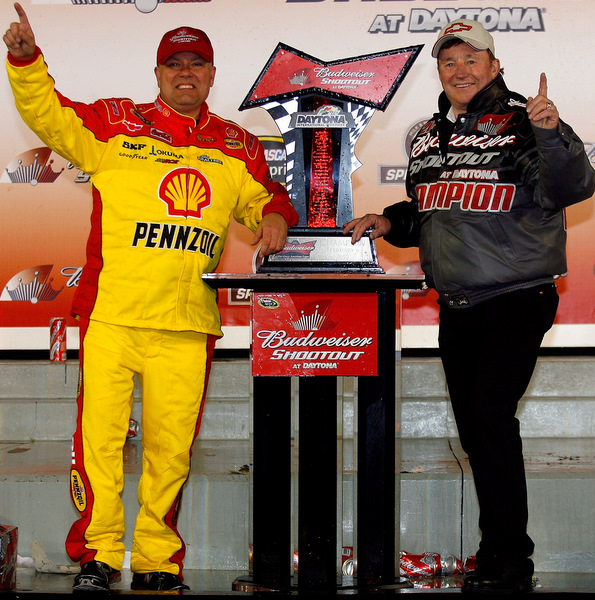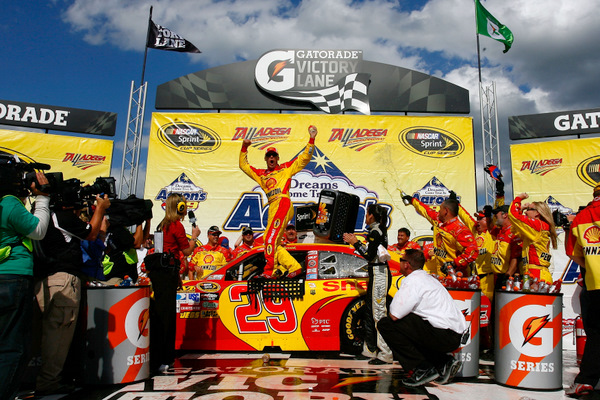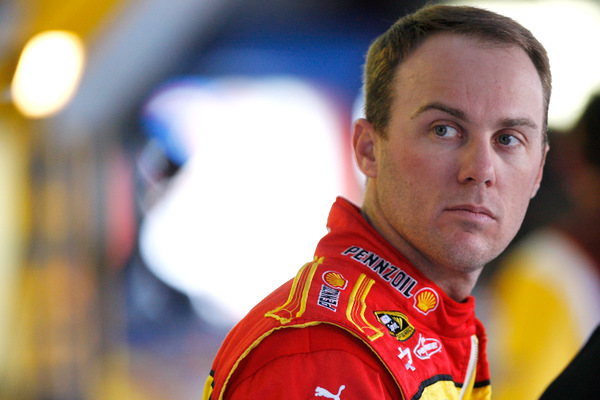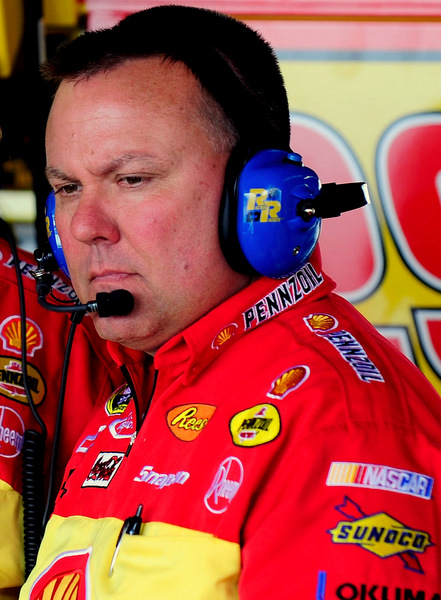Gil Martin's Take: On Kevin Harvick's Talladega win, and the road ahead for RCR

Crew chief Gil Martin (L) and team owner Richard Childress, at Daytona, after opening the season with Kevin Harvick's win in the Shootout (Photo: Getty Images for NASCAR)
By Mike Mulhern
mikemulhern.net
TALLADEGA, Ala.
Karma?
Karmic?
This is the story behind that term used by Kevin Harvick moments after his photo-finish victory over Jamie McMurray in a cool-under-pressure stretch charge by the man who has been car owner Richard Childress' lead driver since that week in 2001 when Childress, following Dale Earnhardt's death, picked him to fill some big, big shoes.
Gil Martin has been carrying a heavy burden. Not only doing all the mind-numbing things any Sprint Cup crew chief has to do, on the tech side and political side and personal side with the crew, but also dealing with a driver who has been, er, ah, finicky perhaps be a good word to describe Kevin Harvick, who for all his driving talent hasn't been the easiest guy to work with over the years.
Last summer a change-in-command for Harvick's team by team owner Richard Childress, in a bid to change the fortune's of Harvick's team, as it went through renegotiation talks with sponsor Shell, put Martin in charge, and moved long-time Harvick team boss Todd Berrier to Burton's team.
During that difficult period Harvick all-but said he planned to leave the Childress camp at the end of his contract, at the end of this season. And there were reports – Harvick himself refused to say much more at all – that Harvick wanted to move on, either to the Joe Gibbs' Toyota camp, as part of a new fourth Cup team, or to the Hendrick-satellite Tony Stewart team, as part of a new third team.
And Shell began analyzing its own options.
Shell is one of this sport's biggest sponsors, and Childress had just lost Jack Daniels as sponsor of his fourth team, forcing him to cut back to three teams. So the lack of success of the Harvick side of the operation was becoming increasingly unsettling on the business side. Sunday's win here broke a winless streak stretching back to Harvick's dramatic Daytona 500 win over Mark Martin in 2007, the first year of the Shell sponsorship.
But as Shell looked around, it found few options very interesting.
That was the way this season started. Shell looking, Childress and Company hoping to get off to hot start and persuade Shell to stay.
And Harvick indeed got off to a hot start, leading the NASCAR standings early, with solid runs, if still no wins (California, where Jimmie Johnson was incredibly lucky to beat Harvick, after that late yellow, could have been a turning point, if Harvick had won).

A long time coming, but timed perfectly: Kevin Harvick back in victory lane with Richard Childress (Photo: Getty Images for NASCAR)
However Shell made a late pitch to rival team owner Roger Penske just a few weeks ago – insisting however that Penske put 2004 tour champ Kurt Busch at the wheel, and move long-time sponsor Miller Lite to another team, and drop long-time (19 years) oil sponsor Mobil (ExxonMobil). That Penske could put that whole package together so quickly says a lot about the economic power Shell was willing to put on the table.
So now Shell will have Penske and Busch next season....and Harvick and Childress are looking for a new sponsor...and a new contract.
Just what might be going on behind the scenes in all this? Hey, the decline and fall of the American newspaper business has given NASCAR such a big hit that there are virtually no journalists still covering this sport, even part-time, except for the TV side. So there are few men or women left to dig through the garage to see just what Kasey Kahne, for example, might be doing (Kahne began talking late last summer, and yet nothing firm broke in the media until two weeks ago, after his deal with Rick Hendrick was already done).
But the story out front has been clear most of the spring – that the Childress operation has turned a corner in the long-suffering battle against king-of-the-hill Rick Hendrick.
"It shows everybody exactly what we were talking about going into the season -- we really restructured a lot of things over the winter...and all three teams have been strong, and everybody is running up front," Martin says, with a nod toward the man behind the scenes of the technological changeups, Scott Miller, the new competition director, and a man seemingly perfect for the job.
Not only did Harvick win Sunday's 500, but teammate Jeff Burton, with decidedly different strategy – charging to the front and playing very aggressively all afternoon – showed perhaps the strongest car. Only an odd pit call late that put Burton back in traffic for a late restart cost him a shot at the win – when Jimmie Johnson tried to pull in front of teammate Jeff Gordon to hook up, only to misjudge Gordon's closing speed, helping trigger the crash that took out Burton and Gordon.
Martin points out that, despite all the internal turmoil over sponsorship and contracts at RCR, the operation can still perform at peak: "With everything that's going on...this just shows everybody....
"I hate that Shell/Pennzoil is leaving (the sponsor itself has to be billed officially as Pennzoil or Shell/Pennzoil, because of NASCAR's quirky 'exclusivity' contracts, this one with official fuel supplier Sunoco), but the fact is we've got a top-notch team -- so we're looking for somebody to come on board and start the next chapter at RCR with them," Martin says.

Kevin Harvick (Photo: Getty Images for NASCAR)
Speaking of gas, with the Talladega 500 being stretched an extra 32 miles, with a record three green-white-checkered two-lap sprints, how did Martin play that part of this end-game?
The whole fuel situation was unsettling, because a number of teams were worried about running out of gas. And that could have created a major safety issue – one man in the lead pack suddenly having his engine burp and lose power could have led to a major crash.
Martin agreed: "It's extremely nerve-wracking -- we were worried about trying to pass, we were worried about running out of fuel...and you're also worried about running out of fuel with somebody right on your rear bumper too, because that could have caused calamity."
So?
"You don't really plan for it," Martin went on. "But we stretched it one extra lap on everybody -- I think the lap was 147 (of a scheduled 188, which actually went 200), and we knew at that point that we had five laps to spare for a green-white-checkered," Martin said.
"But what you can't factor in is how many laps it's going to go during each one of those cautions."
That is, when NASCAR calls for a green-white-checkered, it can run any number of laps under the yellow before finally throwing that green. And NASCAR can do that three times, under the new twist it added in February.
"So immediately when that caution came out, 182 or something, we immediately started telling Kevin to save fuel," Martin said. "He was cutting the engine off, and things like that. Now it's hard to factor how much fuel that actually saves, but every caution lap is 2 to 1 (in fuel mileage, two laps under caution eats up as much gas as one lap of green), so we knew we had it bumped up to around lap 200.
"We were just glad that last caution had a pretty fast clean-up.
"I think it was to our benefit the Nationwide race was scheduled (part of a rain-created double-header, which led to the speed-up)."
For all the drama Harvick provided in the final miles (and his tight push for leader Jamie McMurray that led to the key final breakaway was perhaps the cool move of the race, even more than his last lap pass), the first two hours of the race he lounged around in the back of the pack, with teammate Clint Bowyer, Carl Edwards, McMurray and Juan Pablo Montoya.
"Every year here we usually race upfront, try to put on the show, lead a lot of laps, and race up front...and we end up crashed," Martin said.
"So this time we knew we were going to race conservatively in the beginning, and then try at about 50 laps to go to get going.
"A couple of points during the race he'd made that move (charge and pass), so he knew what he had to do. With about 15 or 20 to go, he pretty well called that move (waiting till the trioval the last lap to make a pass) -- He told our spotter we wanted to be second coming into the trioval....because we knew once we went to the left-side (inside) of him that the air was going to catch that (lead) car in the front (McMurray), and we ought to be able to side-draft down the hill of the tri-oval to the start-finish. And that's exactly what happened."
The side-draft slows a rival by playing with the air.
Despite all the hand-wringing about NASCAR's new rear-spoiler here and its call on restrictor plate size and rear end gearing options, the 500 turned out to be not only an amazingly classic Talladega race in itself but also a classic 'old time' Talladega slingshot, well, of sorts.
"I hate to show my age," Martin said with a grin, "but that was a tremendous pass just like the old days -- like you would have seen Buddy Baker or Cale Yarborough do here.
"That was a tremendous pass, and it was timed perfectly.
"I have to applaud the whole deal, because the cars were able to slingshot and pass like that.
"When we pulled out with the wing (which has now been replaced by the 'old' flat-blade rear spoiler), we kind of stalled out.
"But with the (flat) spoiler, the cars can get the side-draft, and propel you right by the next car. Now it wouldn't last but about half a lap, or maybe not even that far, half a straightaway, but at least it still worked."
One man could pass another, though not hold the spot that long. And, a two-car draft (more efficient aerodynamically than that big pack) could make an amazing run on the leaders, though not hold that spot that long either.
And the drivers spent maybe half the race trying to figure that out, since this was the first race with this setup.
At least Martin and Harvick had plenty of days to ponder this whole Talladega thing: "We've been together tied at the hip for almost three weeks now, with the extended stay in Texas, and then going straight from Texas to the Indy tire test, and then straight to here...." Martin said.
"We've had a lot of opportunities to play this race out.
"I wish I had it on paper -- everything that we talked about -- because I don't think it could have happened more picture-perfect.
"It was just one of those days that whatever we tried to do, it actually worked.
"Those days don't happen very much."
And Martin and Harvick realize that perhaps better than most.
[Note: You can use Twitter as an easy headline service for mikemulhern.net stories, with our instant Tweets to your mobile as soon as our newest NASCAR story is filed. And mikemulhern.net is mobile-friendly for viewing. You can also use the orange RSS feed button as a quickie headline service on your laptop or home computer for mikemulhern.net stories, by creating a Live Bookmark RSS feed on your web browser's toolbar. Or you can create a Google Alert for mikemulhernnet.]

Gil Martin: a lot on his shoulders lately (Photo: Getty Images for NASCAR)
© 2010-2011 www.mikemulhern.net All rights reserved.
Web site by www.webdesigncarolinas.com







What's the difference between
What's the difference between a competition yellow at the beginning of a race vs one at the end of a race?
Is the comp. yellow at the beginning of a race, REALLY for safety, like if there's an "issue" with the tires, after ALL the testing, ALL the manufacturing, etc. that's going on....are they going to stop the race if a team(s) are aggressive with the set-up?
Maybe NASCAR should implement a "competition yellow" near the end of the race, at least 35 laps to go for Daytona and Talladega races, 50 laps for Intermediate tracks like Charlotte and 75 laps for Short tracks from the race's end for fuel only. It would be a monkey-wrench in strategy but fuel mileage won't be an issue, just hardcore racing to the end.
Hell, they've already made racin' a circus for t.v., with the green-white-checkered finish might as well finish the show up strong!
Post new comment